In our laboratory, we work on the development and application of methods using bioaffinity interactions of molecules to detect, determine, identify, and / or separate them.
DEVELOPMENT OF DETECTION SYSTEMS
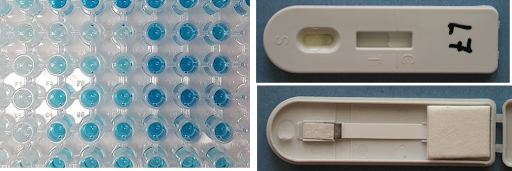
First of all, we are engaged in the development of detection systems for determination of both, high and low molecular substances. These are single or multianalyte immunochemical techniques ELISA (Enzyme Linked Immunosorbent Assay) and LFIA (Lateral Flow Immunoassay), respectively. These methods utilize the existence of non-covalent interactions; mainly between antigen-antibody, biopolymer-solid surface, avidin-biotin and others. In recent years we have been focusing mainly on the application of immunochemical techniques for the detection and determination of environmental contaminants (e.g., pesticides), analytes from clinical biochemistry (e.g., anabolics, drugs), isoflavonoids, microorganisms (Listeria monocytogenes, genus Cronobacter), and their products (enterotoxins, Staphylococcus aureus).
Current projects
Detection of anabolic androgenic steroids (AAS) in food samples

- development of quick and simple methods to reliably detect AAS in food supplements
Anabolic androgenic steroids are synthetic derivatives of testosterone. Nowadays they are used not only in medicine to support medical procedures, but also in sports as illegal doping to support rapid muscle mass growth and overall body strengthening. The free sale of these substances is prohibited, but they may be illegally sold, for example in the form of food supplements, without mentioning it on the packaging label. This behavior is primarily a threat to customers who buy a product without a declared content of anabolics, and therefore use these substances unknowingly.
New Psychoactive Substances Detection (NPS)
- development of immunochemical methods for the detection of synthetic cannabinoids or tryptamines in biological fluids
NPSs are synthesized as structural analogues or chemical derivatives of already controlled substances. This is due to the efforts of manufacturers and distributors to circumvent existing legislative standards in which narcotic drugs and psychotropic substances are usually defined exhaustively.
STUDY OF CRONOBACTER BACTERIA

Another gripping area of our interest are bacteria of the genus Cronobacter, opportunistic pathogens causing life-threatening infections, mainly in newborns and individuals with weakened immunity. We study these microorganisms from their basic properties to their interactions with the host organism. The methods used include a variety of approaches; e.g., isolation and purification of cell fractions and proteins, PCR, RFLP, MLST, mass spectrometry, work with databases and tissue cultures.
Current projects
Investigation of bacteria of the genus Cronobacter
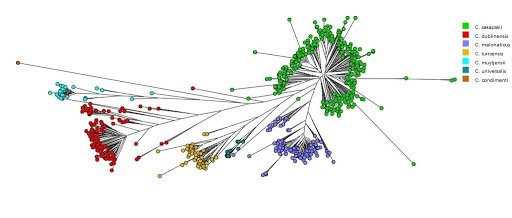
- detailed characterization and accurate identification
Bacteria of the genus Cronobacter are very diverse in their properties and abilities. This diversity has caused a rapid development of their taxonomy and still presents us with new challenges in their accurate identification and classification. We mainly use the methods of molecular biology PCR and MLST and mass spectrometry MALDI-TOF/TOF.
- interspecies variability
Currently, the genus Cronobacter includes seven species. According to the World Health Organization (WHO, 2008), the whole genus is seen as a pathogenic organism, although according to epidemiological studies, C. sakazakii and C. malonaticus are mainly associated with infections. It is therefore interesting to observe the differences in the characteristics and behavior of individual species and try to find connections with the degree of pathogenicity.
- interaction of bacteria of the genus Cronobacter with cell lines
Some virulence factors have been described in the literature, but the process of pathogenesis remains unclear. In particular, protein expression in the host environment is almost non-mapped. Identification of strains capable of adhesion and invasion into human cell lines and monitoring of these interactions would be the first step to the subsequent study of virulent proteins that are expressed directly in the host by the pathogen.
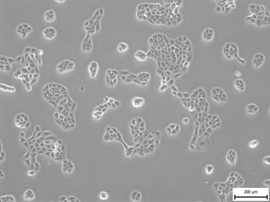
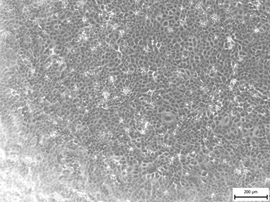
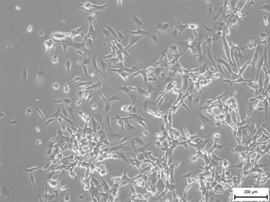
- identification of virulence factors in pathogenic members of the genus Cronobacter
The aim of this part of the work is to find proteins that are unique to pathogenic species. It is very likely that these are virulence factors and their identification would contribute to the understanding and description of the pathogenesis. Furthermore, these proteins could be used for the development of immunochemical methods. These methods excel in speed and low cost and would be a good tool for detecting pathogenic Cronobacter species.
Proteins are isolated from various cell fractions, characterized by SDS-PAGE and identified by LC-ESI-Q-TOF MS. To search for suitable proteins for the immunochemical detection, the immunomagnetic separation is used.
Selected publications
Šuláková, A., Fojtíková, L., Holubová, B., Bártová, K., Lapčík, O., Kuchař, M. Two immunoassays for the detection of 2C-B and related hallucinogenic phenethylamines.: J. Pharmacol.Toxicol 2019, 95, 36-46.
Holubová, B., Mikšátková, P., Kuchař, M., Karamonová, L., Lapčík, O., Fukal, L. (2019): Immunochemical techniques for anabolic androgenic steroid – matrix effects study for food supplements. Eur. Food Res. Technol. 2019, 245, 1011-1019.
Karamonová L., Holubová B., Jelínková A., Novotný J., Svobodová B. Stafylokokové enterotoxiny – superantigeny schopné ošálit imunitní systém. Chem Listy 2019, 113(11), 668-674.
Fojtíková L., Holubová B., Kuchař M., Lapčík O., Maryška M., Šuláková A. Tryptamine derivates having short linking bridge bearing carboxy functional group, and chemical processes for preparing the compounds useful for preparing immunogens by conjugation with the carrier protein. CZ Patentový spis 307719-B6, 2019.
Vlach J, Javůrková B, Karamonová L, Blažková M, Fukal L: Novel PCR-RFLP system based on rpoB gene for differentiation of Cronobacter species. Food Microbiol 2017, 62, 1-8.
Svobodová B, Vlach J, Junková P, Karamonová L, Blažková M, Fukal L: Novel method for the reliable identification of Siccibacter and Franconibacter strains: From ‘pseudo-Cronobacter’ to new Enterobacteriaceae genera. Appl Environ Microbiol 2017, 83(13), e00234-17.
Fojtíková L, Fukal L, Blažková M, Sýkorová S, Kuchař M, Mikšátková P, Lapčík O, Holubová B: Development of enzyme-linked immunosorbent assay for determination of boldenone in dietary supplements. Food Anal Methods 2016, 9(11), 3179-3186.
Svobodová B, Vlach J, Junková P, Karamonová L, Blažková M, Fukal L: Novel method for the reliable identification of Siccibacter and Franconibacter strains: From ‘pseudo-Cronobacter’ to new Enterobacteriaceae genera. Appl Environ Microbiol 2017, 83(13), e00234-17.
Jurášek M, Göselová S, Mikšátková P, Holubová B, Vyšatová E, Kuchař M, Fukal L, Lapčík O, Drašar P: Highly sensitive avidin-biotin ELISA for detection of nandrolone and testosterone in dietary supplements. Drug Test Analysis 2017, 9(4) 553-560.
: Diversity of O-antigens within the genus Cronobacter: from disorder to order. Appl Environ Microbiol 2015, 81, 5574-5582.
: The potential of matrix-assisted laser desorption/ionization time-of-flight mass spectrometry for the identification of biogroups of Cronobacter sakazakii. Rapid Commun Mass Spectrom 2013, 27(3), 409-418.
: Rapid Immunoassays for Detection of Anabolic Nortestosterone in Dietary Supplements. Czech J Food Sci 2013, 31(5), 514–519.
: Immunochromatographic strip test for detection of genus Cronobacter. Biosens Bioelectron 2011, 26(6): 2828-2834. ISSN 0956-5663.
Group members
head of the group:
prof. Ing. Ladislav Fukal, CSc.
assistant professors:
doc.Ing. Barbora Holubová, Ph.D.
Ing. Ludmila Karamonová, Ph.D.
doc. Ing. Martina Krausová, Ph.D.
PhD students:
technician:
